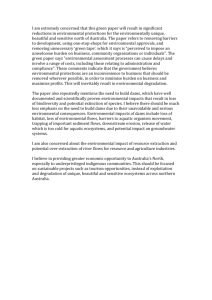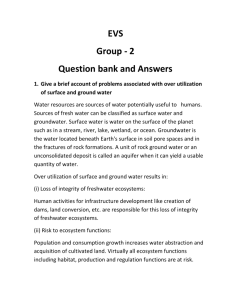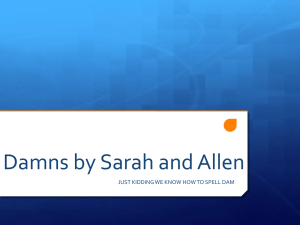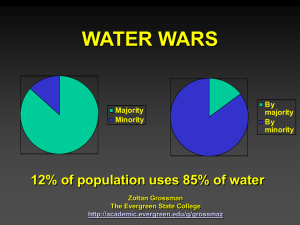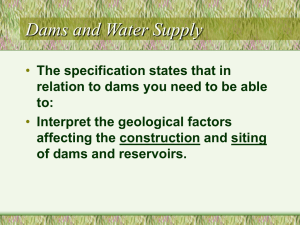Перечень докладов конгрессов Международной комиссии по
advertisement
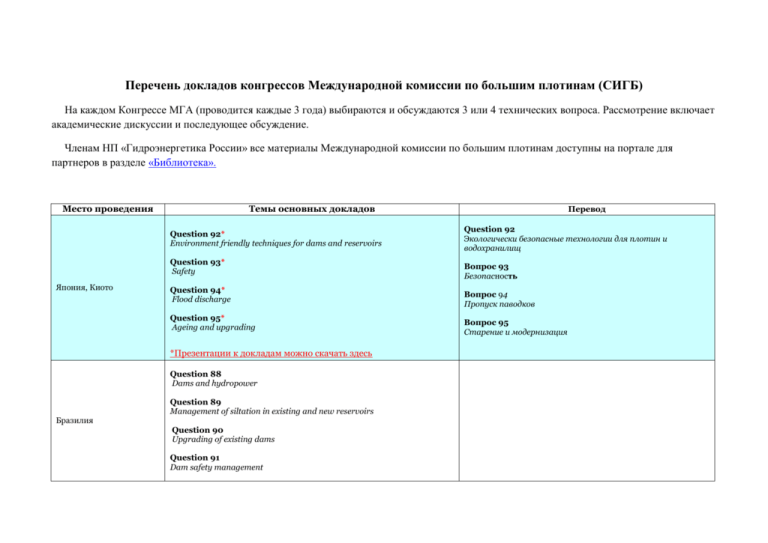
Перечень докладов конгрессов Международной комиссии по большим плотинам (СИГБ) На каждом Конгрессе МГА (проводится каждые 3 года) выбираются и обсуждаются 3 или 4 технических вопроса. Рассмотрение включает академические дискуссии и последующее обсуждение. Членам НП «Гидроэнергетика России» все материалы Международной комиссии по большим плотинам доступны на портале для партнеров в разделе «Библиотека». Место проведения Темы основных докладов Question 92* Environment friendly techniques for dams and reservoirs Question 93* Safety Япония, Киото Question 94* Flood discharge Question 95* Ageing and upgrading *Презентации к докладам можно скачать здесь Question 88 Dams and hydropower Бразилия Question 89 Management of siltation in existing and new reservoirs Question 90 Upgrading of existing dams Question 91 Dam safety management Перевод Question 92 Экологически безопасные технологии для плотин и водохранилищ Вопрос 93 Безопасность Вопрос 94 Пропуск паводков Вопрос 95 Старение и модернизация Question 84 Technical solutions to reduce time and cost in dam design and construction. Испания, Барселона Question 85 Management of the downstream impacts of dams operation. NOTE: The Question is exclusively related to impacts and risks during operation of dams which could include large flooding releases for the maintenance of downstream ecological systems. Consequences of dam failures and of operation during extreme floods are not included in the Question. Some aspects related to water quality such as problems of fish may be included. Question 86 Safety of earth-and rockfill dams. Question 87 Flood and drought evaluation and management. Question 80 Financing hydraulic projects including dams. NOTE: The Question includes the financing of rehabilitation works related to existing structures. The reports should preferentially deal on developing countries. Question 81 Economic evaluation of hydraulic projects including dams. Канада, Монреаль Question 82 Ageing and rehabilitation of concrete and masonry dams and appurtenant works. NOTE: The Question excludes the damages covered by routine maintenance, not affecting dam safety. Question 83 Seismic aspects of dams. NOTE: The Question covers all types of dams including tailings dams. Question 76 The use of risk analysis to support dam safety decisions and management. Китай, Пекин Question 77 Benefits and concerns about dams. Question 78 Monitoring of dams and their foundations. Question 79 Gated spillways and other controlled release facilities and dam safety. Question 72 Innovative financing of projects involving dams. Италия, Флоренция Question 73 Special problems with earthfill dams. Note: This Question excludes (i) purely numerical procedures, (ii) impervious elements other than earth cores, (iii) overtoppable earthfill dams. Question 74 Performance of reservoirs. Question 75 Incidents and failures of dams. Question 68 Safety assessment and improvement of existing dams. Франция, Дурбан Question 69 Environmental experience gained from reservoirs in operation. Question 70 Staged construction, raising or modification of dams. Question 71 Deterioration of spillways and outlet works. Question 64 Environmental issues in dam projects. Австрия, Вена Question 65 Ageing of dams and remedial measures. Note: Ageing = changes with time of structural properties of dams (geometrical and physical-mechanical, hydraulic, thermal, etc.) Which influence the structural safety, occurring under normal operational conditions. Question 66 Dams on difficult foundations. Question 67 New developments for fill dams and fill cofferdams. Question 60 Reservoirs and the environment-Experience in management and monitoring. США, Сан-Франциско Question 61 Embankment dams: impervious elements other than clay cores. Question 62 New developments in the construction of concrete dams. Question 63 Design flood and operational flood control. Question 56 Dams and foundation monitoring. Швейцария, Лозанна Question 57 Concrete dams-an old problem always present: cracking: a new technology: rolled concrete (rollcrete). Question 58 Foundation treatment of seepage. Question 59 Rehabilitation of dam to ensure safety. Question 52 Safety of dams in operation. Question 53 Influence of geology and geotechnics on the design of dams. Бразилия, Рио де Жанейро Question 54 Reservoir sedimentation and slope stability. Technical and environmental effects. Question 55 Materials and construction methods for embankment dams and coffer dams. Question 48 Interface problems of dams. Индия, Нью Дели Question 49 Deterioration or failure of dams. Question 50 Large capacity outlets and spillways. Question 51 Seismicity and aseismic design of dams. Question 44 Problems associated with special types of fill dams. Question 45 Leakage investigations and drainage of dams and their foundations. Мексика, Мехико Question 46 Preliminary planning of dam developments. Question 47 The effects on dams and reservoirs of some environmental factors. Note: Discussion of the influences of dams and reservoirs on the environment is to be excluded as having been covered in Question 40, 11th Congress. Question 40 The consequences on the environment of building dams. Испания, Мадрил Question 41 Flow control and energy control during construction and after completion. Question 42 Impervious elements and slope protection on earth and rockfill dams. Question 43 New ideas for more rapid and economic construction of concrete dams. Question 36 Recent developments in the design and construction of earth and rockfill dams. Канада, Монреаль Question 37 Recent developments in the design and construction of dams and reservoirs on deep alluvial, karstic, or other unfavourable formation. Question 38 Supervision of dams and reservoirs in operation. Question 39 Recent developments in the design and construction of concrete dams. Question 32 The safety of dams from the point of view of the foundations and the safety of reservoir banks. Турция, Стамбул Question 33 Temporary and permanent provisions for the control of flows. Question 34 The behaviour and deterioration of dams. Question 35 Dams in earthquake zones or other unfavourable situation. Question 28 Physical and mechanical properties of rock in situ, means of determining these properties and improving them, with special reference to the design and construction of large dams. Шотландия, Эдинбург Question 29 Results and interpretation of measurements made on large dams of all types, including earthquake observations. Question 30 Design of concrete for large dams of all types and influence of age on concrete properties. Question 31 Design, methods of construction and performance of high rockfill dams (above or about 80m). Question 24 The selection, processing and specification of aggregates for concrete for large dams. Италия, Рим Question 25 Underground work in connection with large dams. Question 26 odern techniques of concrete dams for wide valleys and ancillary works. Question 27 Sealing of earth and rockfill dams with bitumen and other materials. Question 20 Heightening of existing dams including methods of constructing new dams in successive stages. США, Нью-Йорк Question 21 Observation of stresses and deformations in dams and in their foundations and abutments; and a comparison of these observations with computations and tests on small scale models. Question 22 Compaction methods and moisture content for materials used in the construction of earth core and supporting fill for earth and rockfill dams. Question 23 Use of admixtures and pozzolanic materials in concrete for dams and the influence of the finer sand particles. Question 16 Design and construction of dams on permeable soils and methods of foundation treatment. Question 17 Economics and safety of different types of concrete dams. Франция, Париж Question 18 Settlement of dams due to compressibility of the dams materials or of the foundations soil, including earthquake problems. Question 19 The relation of the cement of the concrete to performance in practice of: a) gravity dams (interior and exterior); b)arch dams; c) buttress dams and its influence on permeability and frost resistance. Question 12 Methods for determining the maximum flood discharge that may be expected at a dam and for which it should be designed. Selection of type, capacity and general arrangements of temporary or permanent outlet and spillways. Индия, Нью Дели Question 13 Design and construction of earth and rockfill dams with their core walls and diaphragms. Question 14 Sedimentation in reservoirs and related problems. Question 15 Concrete for large dams. Question 8 Uplift and resulting stresses in dams. Швеция, Стокгольм Question 9 Methods and instruments for measuring stresses and strains in earth and concrete dams. Question 10 Most recent dispositions to avoid piping. Question 11 Information obtained from the use of testing methods and of special cements in larges dams. Question 3 Special cements. Question 4 Design and waterproofing of shrinkage, contraction and expansion joints. США, Вашингтон Question 5 Study of facing of masonry and concrete dams. Question 6 Geotechnical studies of foundations of earth dams. Question 7 Calculation of stability of earth dams. Question 1a Deterioration by ageing of the concrete of weight dams. Question 1b Influence of internal temperature and distortion of weight dams. Швеция, Стокгольм Question 2a Research methods so as to ascertain whether a given materials is suitable for being used in the construction of an earthdam. Question 2b Study of physical laws governing infiltration of water through the dam and the subjacent soil.

